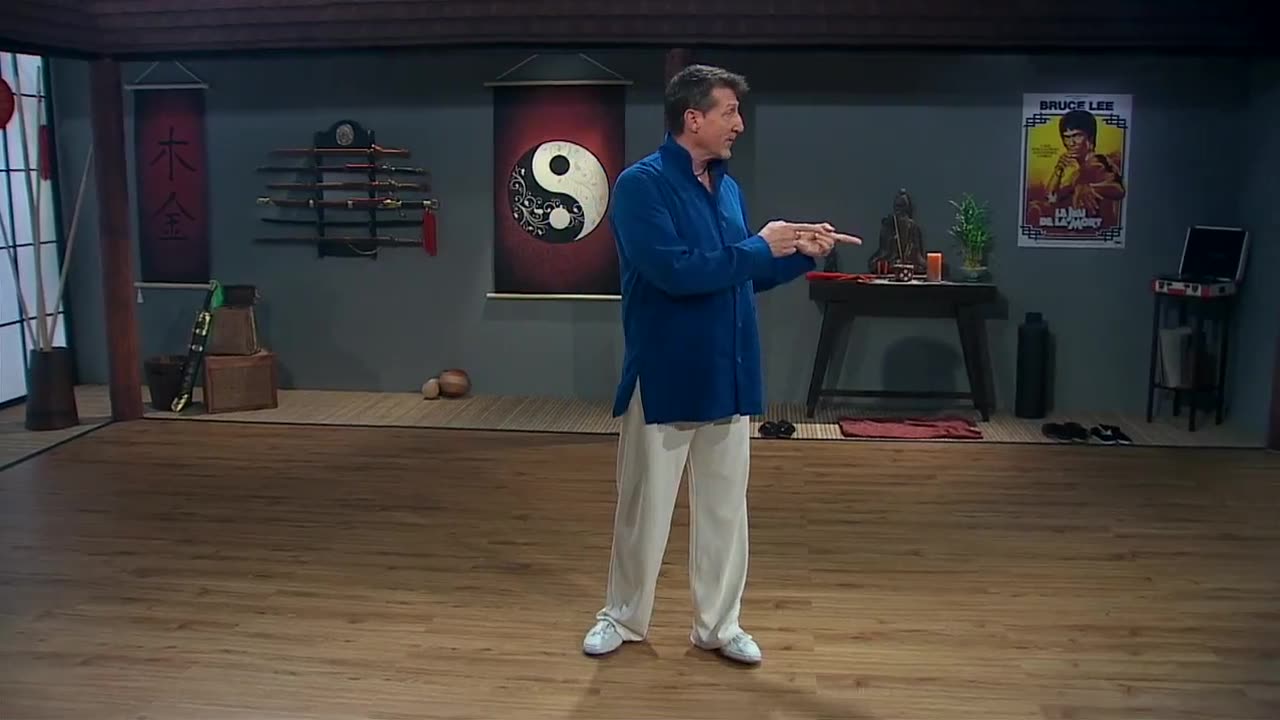Premium Only Content

17. Bouncing Away Conflict
We’re getting pretty far into our 40-movement routine, and in this
lecture, we’ll continue to advance with a new move: snake creeps
down. We’ll also begin a discussion of something called the eight original
intentions of tai chi. We’ll focus on the first four intentions, which have
practical applications for real-life defense.
Snake Creeps Down
● The next movement we’re going to learn is snake creeps down.
From the end of riding the tiger, sit back, turn the waist to the left,
and circle the hands. The right hand goes upward and across the
chest; the left hand goes downward and outward, then upward.
● Bend the left leg to form a crouch step and turn the waist to the
right, raising the left hand up in a hook hand (shoulder high) as
you sink. Meanwhile, drop the right hand down past the ribs as
you sink, then along the inner side of the right leg with the palm
facing out, fingertips pointing to the west.
● Shift the weight onto the right foot to form a bow step. Raise the
right palm to shoulder level, while the hook hand drops behind
your back, fingers pointing up.
The Eight Original Intentions
● Drawn from the tai chi classics, the eight original intentions are
given as a starting point for tai chi movements.
● They can be thought of as the eight original conflict-management
strategies. Here they are:
1. Peng: ward off
2. Lu: roll back
3. Ji: press
4. An: push
5. Tsai: yank down
6. Lieh: splitting apart
7. Chou: give the elbow
8. Kao: give the shoulder
● You can see the first four intentions in the move grasp the bird’s
tail. We’ll discuss the final four intentions in a later lecture, but the
first four have practical real-life uses.
● Any fight or martial art is really about conflict management. A fight
is really nothing more than a relationship gone horribly wrong for
the moment. What do you do when you’re in a moment of conflict
that you want to manage?
● When somebody comes at you with a verbal, physical, or
emotional attack, the first thing you could do is create a bubble
around yourself. Essentially, that’s what ward off (peng) is all
about: bouncing energy away.
● Maybe that technique doesn’t work, so you absorb their attack, but
deflect it off to the side (lu). Not everyone can do that, but if you
can, that’s a great conflict management strategy.
● Say that one doesn’t work. The next thing you can try is to realize
this conflict really has nothing to do with you. The anger is coming
from someone else, so you can try to gather it all up and send
it back (ji).
● If that doesn’t work, you can try to realize that maybe the argument
isn’t about what it seems to be about on the surface. There could
be something deeper going on. Take it in, let it lift you up, and let
it go (an).
-
 30:13
30:13
Mastering Tai Chi
1 year ago22. Lotus Kick And Laughing Buddha
253 -
 2:42:21
2:42:21
RiftTV/Slightly Offensive
7 hours agoLAPD Shot ME?! Rioters RAN OVER, US Attacking Iran? | The Rift | Guest: Anna Perez + Braeden Sorbo
75.1K23 -
 2:12:14
2:12:14
TubButter
1 day ago $0.80 earnedMy aim is sharper in 1440P Warzone! (Maybe). 😉 Live now! #Warzone #1440p #FunnyFails #TubButter
35.2K -
 1:49:01
1:49:01
The Confessionals
12 hours agoThe Invisible War They Don’t Want You to See (It Didn’t Start With You)
29.3K4 -
 1:16:48
1:16:48
Adam Does Movies
1 day ago $0.25 earnedMovie Hangout + Ask Me Anything - LIVE!
19.1K2 -
 2:01:11
2:01:11
Anthony Rogers
1 day agoEpisode 371 - Exposing the Devil's Playbook
22.3K4 -
 2:16:42
2:16:42
RJTWIN
3 hours ago🔴LIVE - 2 Men, 0 Plans | Warzone | Clean Content - !blerp !discord !rumbot
4.9K -
 LIVE
LIVE
The Sufari Hub
4 hours ago🔴LIVE | DUMB AND DUMBER TAKEOVER THE ZOMBIE APOCALYPSE | DAY 7 HERE WE COME
16 watching -
 9:42
9:42
The Shannon Joy Show
6 hours ago🔥 AI Tyranny Unleashed — Trump & Gates Just Sold Us Out 🔥
12.6K8 -
 3:10:13
3:10:13
blackfox87
4 hours agoFortnite Assemble! | #DisabledVeteran
10.2K